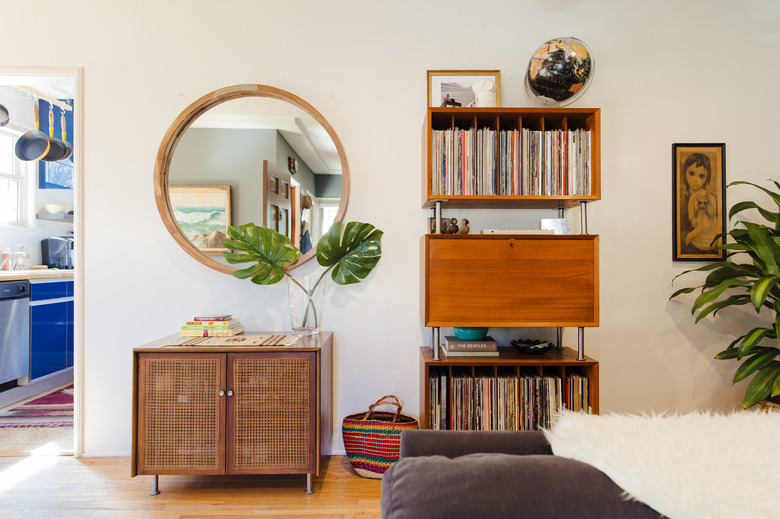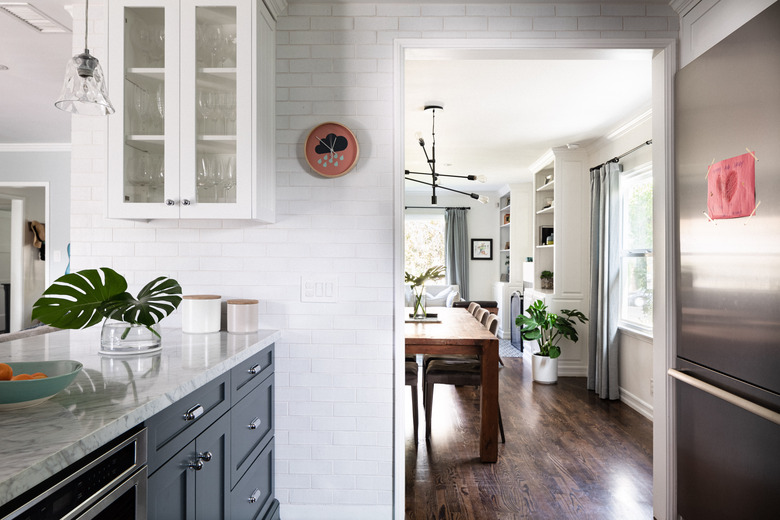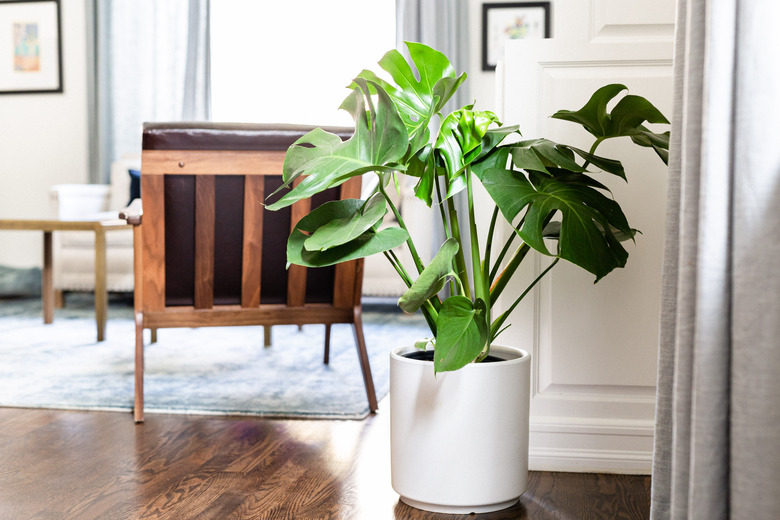Glue-Down Vs. Floating Vinyl Plank Flooring
The popularity of vinyl flooring peaked during the housing boom of the 1950s, when glue-down sheet flooring and tiles were all the rage, and it has managed to remain trendy as manufacturers continue to develop different formats and designs. Vinyl plank flooring, first introduced in the 1970s, is waterproof, scuff and stain resistant and easy to install, and it mimics the look of more expensive hardwood, so it's a great option for any room in the house.
In the early days of vinyl flooring, glue-down flooring was all you could get, but contemporary homeowners can choose between glue-down vinyl plank flooring and click-together or glue-together planks that create a floating floor. Although the planks that form a floating floor are generally more upscale than glue-down planks and are the ones preferred by the DIY installer, they aren't necessarily the best choice for every situation. Anyone who is considering installing new vinyl flooring should have a handle on the pluses and minuses of both formats to get the best value and functionality from the new floor.
Issues to Consider
Issues to Consider
One room's floor is another room's ceiling, and flooring affects sound transmission as well as heat and moisture conduction between the two spaces. It's also an integral design component of the room, and of course, it's what you walk on, so it has to be durable to stand up to foot traffic. As you evaluate each type of flooring, these are important points to consider, and if you settle on vinyl, you should also consider these issues:
- Size of the floor: Click-together floating floors don't work as well in large, open rooms as glue-down floors because the larger the room, the more likely the chance of the planks separating. Glue-down floors are stuck to the subfloor, so they can't separate.
- Subfloor type: You can install both glue-down and floating floors over most subfloor materials, including concrete, plywood and oriented strand board (OSB), but the requirements are more stringent for a glue-down floor. If the floor isn't perfectly flat and dry, the planks will lift. A floating floor, on the other hand, can be installed over a subfloor in less-than-perfect condition — even over existing flooring.
- Moisture: A subfloor over a crawl space or below grade isn't a great candidate for a glue-down floor because moisture can degrade the adhesive. On the other hand, you can install a moisture barrier under a floating floor, so it's a good choice for any room in the house.
- Traffic: A glue-down floor is usually a better choice in high-traffic areas like commercial buildings and industrial spaces because the glue provides extra holding power. Around the house, the rooms with the most traffic, such as the front hallway, the kitchen and the recreation room, are better served by glue-down flooring than floating flooring, but if you're considering a whole-house project with one type of flooring, a floating floor would be the more practical as well as more elegant choice.
- Mobility: A glue-down floor is recommended in homes with wheelchairs because the wheels can displace floating flooring planks.
What Are the Available Options?
What Are the Available Options?
When it comes to glue-down vinyl plank flooring, you can choose self-sticking planks or planks that require a coat of adhesive on the subfloor. The adhesive on self-stick planks is pressure sensitive, and one of the problems with it is that it won't adhere to a dusty or uneven surface. Adhesive that you apply with a trowel is known as hard set, and it's less affected by dust and subfloor irregularities, but it is sensitive to temperature and moisture.
Floating vinyl planks are modeled after laminate flooring, and you install them the same way, but because you can cut vinyl with a knife, you can do the job without power tools. Because vinyl is waterproof, floating planks don't require an underlayment, especially if they have a backing, but you can install a vapor barrier if the floor needs extra moisture protection. You can't do that with glue-down vinyl.
Click-together vinyl planks are typically more robust than glue-down planks and can be as thick as 6 millimeters (1/4 inch), according to Parterre Flooring. Glue-down planks, on the other hand, are typically half as thick. The difference? Floating planks often have a rigid core that adds body and some insulation value, which is why click-lock planks are also known as luxury vinyl planks.
Noise Reduction and Insulation
Noise Reduction and Insulation
Sound and thermal insulation are two benefits that come with purchasing a quality product with a core, a backing and a wear layer, such as what you get with luxury vinyl plank flooring. Glue-down flooring seldom has these layers, and since it's half as thick and permanently adhered to the subfloor, it provides very little acoustic muffling. This is important to remember when you're installing flooring on the upper stories of a building.
When you're installing on the ground floor, thermal insulation is more important than sound reduction, and on this count, a floating floor again scores more points. You can choose a product with a cork or foam backing, and if that doesn't have enough insulation value, you can also install an underlayment. By virtue of its being permanently attached to the subfloor, glue-down vinyl plank flooring provides little to no thermal barrier, and if you want the room to be warmer, you'll probably have to use carpets or rugs.
Repair and Maintenance
Repair and Maintenance
Vinyl flooring in general is low maintenance, requiring little more than periodic vacuuming and occasional mopping with warm water and detergent. The fact that you glued down the flooring or installed a floating floor doesn't alter the maintenance requirements. There is a difference between the two types of flooring, however, if one of the planks gets damaged and you have to replace it.
Glue-down planks are easy to replace. Simply heat the plank with an iron or heat gun to soften the adhesive, lift off the damaged plank, spread more adhesive and set a new plank.
The procedure for replacing a floating vinyl plank is a bit more complicated. You have to cut out the damaged plank with a knife and carefully prepare the new one before installing it. While it's a job you can do yourself, it can be time-consuming enough to warrant calling a professional installer for help.
Materials and Installation Costs
Materials and Installation Costs
Compared to flooring materials such as hardwood and ceramic tile, vinyl plank flooring and luxury vinyl tile, a related product, are definitely on the less-expensive side, and that's one reason for their popularity. When it comes to the cost of materials, there isn't a huge difference between different plank formats. Floor Critics reports that on average, glue-down planks cost around $1.70 per square foot, while the 2019 cost of floating planks is in the neighborhood of $2.99 per square foot.
The cost of installation is the great equalizer. It can vary widely depending on where you live and the size of your floor, but it's generally in the range of $1 to $3 per square foot for vinyl plank flooring. If you install a floating floor, you can probably do the installation yourself because the installation method requires little expertise. You'll probably need a professional installer for a glue-down installation, however, since the process is more complicated. Don't forget to add the cost of glue.
When all is said and done, you'll end up spending roughly the same amount for either type of flooring, so there's no reason to let cost be a determining factor.


